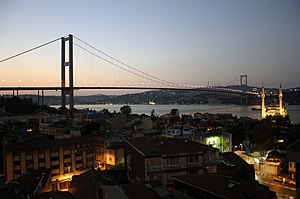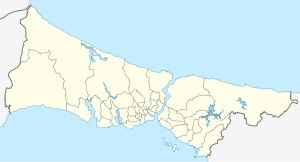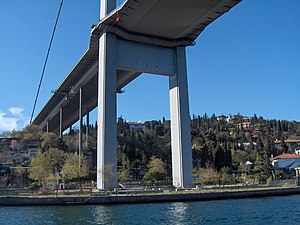Bridge of the Martyrs of July 15th
Coordinates: 41 ° 2 ′ 43 ″ N , 29 ° 2 ′ 4 ″ E
| Bridge of the Martyrs of July 15th | ||
|---|---|---|
| Convicted |
|
|
| Crossing of | Bosporus | |
| place | Istanbul | |
| construction | Suspension bridge | |
| overall length | 1560 m | |
| width | 33.40 m | |
| Longest span | 1074 m | |
| Clear height | 64 m | |
| building-costs | 23.2 million US dollars | |
| start of building | 1970 | |
| completion | 1973 | |
| opening | October 29, 1973 | |
| planner | Freeman Fox & Partners | |
| toll | toll | |
| location | ||
|
|
||
The Bridge of the Martyrs of July 15 ( Turkish 15 Temmuz Şehitler Köprüsü ), formerly called the Bosphorus Bridge (Boğaz Köprüsü) or First Bridge (Birinci Köprü) , is the oldest of three bridges in Istanbul that span the Bosphorus and thus the European one connect with the Asian part of the city. It was opened in 1973 and connects the Beşiktaş and Üsküdar districts on the O-1 motorway . The bridge can also be reached via the TEM ( Trans European Motorway İstanbul-Ankara Otoyolu ) .
description
The Bridge of the Martyrs of July 15 is a suspension bridge with six lanes, two emergency lanes and a footpath. The direction of travel of the main lanes is not fixed, but is adapted to the traffic flow depending on the time of day and day of the week. On weekdays, four lanes run from east to west in the morning and four from west to east in the evening to cope with rush hour traffic from Asia to Europe, where most of the jobs are.
The almost horizontal bridge deck connects the districts on the high banks, the districts directly on the bank are deep under the bridge. It crosses the Bosphorus with a clearance height of 64 m, so that large ships such as aircraft carriers and cruise ships can pass through.
Their length between the anchor blocks on the high banks is 1560 m. The span between the pylons is 1074 m.
Its two steel pylons stand directly on the bank. They are 165 m high and overlook the road by 105 m. Its two legs are connected and stiffened by a crossbar below the bridge deck and by a crossbar halfway above the roadway and by one between the tips.
The bridge deck between the pylons consists of an aerodynamically favorable, flat hollow box made of sheet steel. After the Severn Bridge, the Bosphorus Bridge was the second of the large suspension bridges planned by Freeman Fox & Partners , in which high lattice girders were no longer used to stiffen the roadway girders , but rather hollow boxes tested in the wind tunnel, which offer little resistance to the wind and thanks to their aerodynamic shape avoid vibrations and aeroelastic flutter.
The bridge deck is a total of 33.4 m wide and only 3 m high. It has a 25 m wide flat top, which on both edges merges with a 1.5 m wide slope into the somewhat lower 2.5 m wide footpaths. The flat, only 18 m wide underside of the box girder is connected to the outer edges by a long slope. The footpaths therefore look like an upturned wing.
Only this bridge deck of the main span is suspended from the 58 cm thick suspension cables, similar to the Williamsburg Bridge and the Ambassador Bridge . As with the Severn Bridge, the hangers are attached diagonally so that two hangers always end at a common attachment point on the suspension cables and on the roadway girders, creating a zigzag pattern.
The side openings consist of a steel plate beam construction with two narrow hollow boxes, which are supported by narrow steel pillars. The 231 m long side opening is divided into bridge fields of 40 + 3 × 45 + 56 m; the 255 m long opening is divided into 4 × 63.75 m long fields.
toll
A toll was originally only supposed to be collected in the first three years; it is only due for journeys from Europe to Asia, not the other way around. In addition to paying at the toll station on the Asian side, since 1999 it has also been possible for regular users to debit by radio. Since 2004, only payment by toll card or radio receiver has been possible; payment with cash, like toll booths occupied by people, has been abolished. The bridge is used by around 180,000 vehicles every day. By 1997 there were a total of 1 billion. The toll was never abolished. It amounts to TRY 5.50 for cars (as of October 2014, around € 2), so that the city's monthly income now amounts to € 10 million.
history
The first proposal for the construction of a suspension bridge between Ortaköy and Beylerbeyi was developed in 1951 by the architect Paul Bonatz , eight years later the construction of the bridge was decided under Prime Minister Adnan Menderes in 1959 . Concrete planning began in 1968 in the Freeman Fox & Partners office under the direction of Gilbert Roberts and William Brown. A joint venture between the German Hochtief , the British Cleveland Bridge & Engineering Co. and the Turkish Enka was commissioned with the construction . Construction began in 1970. The construction costs amounted to 23.2 million US dollars . The Bosphorus Bridge was opened on the 50th anniversary of the Turkish Republic on October 29, 1973 by the then President Fahri Korutürk .
For the first four years, the bridge was also open to pedestrians - they were carried by lifts in the pylons from the banks of the Bosphorus to road level. Due to numerous suicidal jumps (around 100 dead to date), the bridge is now closed to pedestrians.
Since 1979 the bridge has been part of the route of the Istanbul Marathon , which leads from Üsküdar to Beyoglu. In 1988, a second bridge called the Fatih Sultan Mehmet Bridge was opened five kilometers north of the bridge . In 2013, construction of a third bridge, the Yavuz Sultan Selim Bridge , began even further north and was completed on March 6, 2016.
During the coup attempt by parts of the Turkish military on July 15 and 16, 2016, the bridge, as a strategically important location, became one of the scenes of violent clashes between the military members who were opposed to the government and supporters of the Turkish president and the Turkish police. On July 25, 2016, Prime Minister Binali Yıldırım announced the decision of the Turkish cabinet to rename the bridge from “Bosphorus Bridge” to “Bridge of the Martyrs of July 15”.
literature
- Bernhard Graf: Bridges that connect the world . Prestel, Munich 2002, ISBN 3-7913-2700-3 .
Web links
Individual evidence
- ↑ Marcel Prade: Les grands ponts du monde . Deuxième partie, Hors d'Europe. Brissaud à Poitiers. ISBN 2-902170-68-8
- ↑ Tolls in Turkey at www.meine-auto.info, accessed October 12, 2014
- ↑ Roland May: Pontifex maximus. The architect Paul Bonatz and the bridges. Monsenstein and Vannerdat, Münster iW 2011, ISBN 978-3-86991-176-2 , pp. 468-470, 588, 660f., 686-688
- ↑ a b Boğaziçi Köprüsü Proje Bilgileri (PDF; 972 kB) on the website of Türkiye Cumhuriyeti Karayolları Genel Müdürlüğü ; Note: In addition to extensive factual material on the bridge, the document also contains pictures from the construction period.
- ^ Turkey coup attempt: Crowds confront soldiers on Bosphorus Bridge. In: BBC . July 16, 2016. Retrieved July 25, 2016 .
- ↑ Boğaziçi Köprüsü'nün adı '15 Temmuz Şehitler Köprüsü 'olarak değişiyor. In: Yeni Şafak . July 25, 2016. Retrieved July 26, 2016 .
- ↑ Bosphorus Bridge renamed July 15 Martyrs' Bridge. In: TRT World . July 25, 2016. Retrieved July 26, 2016 .
- ↑ Istanbul: Turkey opens third Bosphorus bridge , Spiegel Online, August 24, 2016.




